Abstract
Content
- Introduction
- 1. Theme urgency
- 2. Goal and tasks of the research
- 3. Overview of parallel architectures
- 4. Model of parallel system for calculation the parameters of the moving object
- 4.1 General structure of subsystem for calculation the parameters of ship movement
- 4.2 Mathematical model of ship movement
- 5. Experimental results
- Conclusion
- References
Introduction
Safety of vehicles movement is a important task in connection with increase in transport traffic. The problem of safety is actual for inland vessels. In this regard, the integrated navigation systems (INS) [1] were widely adopted for autonomous navigation. The INS subsystem for calculation the coordinates of ship movement trajectory is researched in the master's thesis. The main task of this subsystem is to predict the movement parameters of the ship based on its mathematical model. High-performance systems need to be applied for effective work of subsystem for calculation the parameters of ship movement. The work efficiency of subsystem for calculation the parameters of ship movement at realization on various parallel architectures is researched in the master's thesis.
1. Theme urgency
Speed performance of subsystem for calculation the coordinates of ship movement trajectory determines the efficiency of the INS. In this regard, improving the performance of this subsystem is an urgent task. Low performance of this subsystem does work of the INS ineffective, which could lead to negative consequences. The problem of performance arises at calculation of parameters for group of vessels. In the master's thesis explores issues of ensuring the required performance of subsystem for calculation the parameters of movement.
2. Goal and tasks of the research
The goal of the work is to analyze of overall performance of subsystem for calculation the coordinates of ships movement trajectory, which is implemented on parallel architectures.
Within a master's thesis it is necessary to solve the following tasks:
- develop subsystem for calculation the coordinates of ship movement trajectory based on its mathematical model with using various parallel architectures;
- analyze efficiency of various parallel architectures usage.
3. Overview of parallel architectures
One way to improve the performance of computing systems is the use of parallel architectures. As parallel architectures understand such architectures of computing systems which at hardware level allow to organize parallel data processing. The general classification of parallel computing systems [19] is given in figure 1.
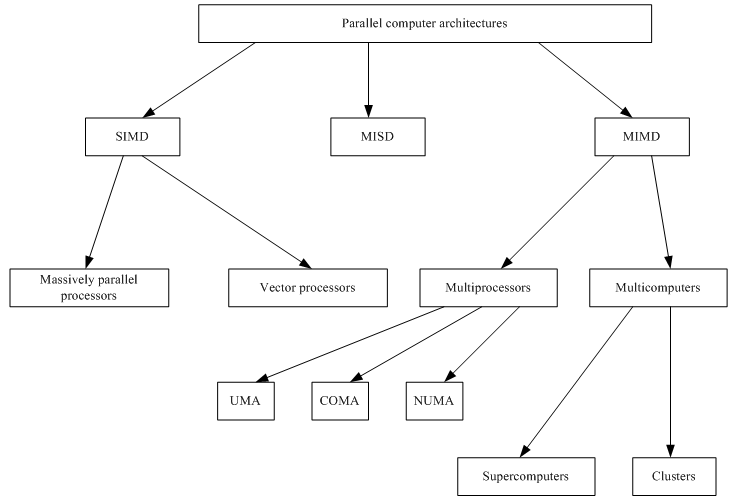
Figure 1 – Classification of parallel architectures
The architecture of SIMD (Single Instruction stream Multiple Data stream) underlies computing systems which cope one stream of commands which process some data streams. Massively parallel processors and vector processors belong to versions of such systems.
The massively parallel processor is a set of one-type processors, each of which has the local memory. The uniform control unit makes active processors on performance of the same sequence of teams, but over different data which are loaded into local modules of memory.
Basis of the vector processor is a vector arithmetic logic unit (ALU). Vector ALU is a set of in parallel functioning usual ALU which carry out at the same time one action over the corresponding elements of data vectors which are stored in special vector registers.
The architecture of MISD (Multiple Instruction stream Single Data stream) isn't used at macrolevel (level of machine commands) known computing systems. At the MISD microlevel represents the pipelined superscalar organization of computing.
MIMD architecture (Multiple Instruction stream Multiple Data stream) underlies multiprocessors and multicomputers.
The multiprocessor is a set of processors which work in parallel in one address space and use the uniform copy of an operating system. When blocking any process its processor keeps the condition in tables of an operating system and transfers control to other processor. Uniform representation of computing process which is used by all processors, is stored in shared memory.
According to way of realization of shared memory distinguish three types of architecture of multiprocessors:
- UMA (Uniform Memory Access) is architecture, at which identical time of the access to any module of memory;
- NUMA (NonUniform Memory Access) is architecture with non-uniform access to memory in which shared memory is realized so that access time from the concrete processor to one modules significantly differs from access time to another;
- COMA (Cache Only Memory Access) is architecture in which the main memory of each processor (local memory) is organized as a cache memory.
The multicomputer is the computing system without the general memory which consists of a large number of the interconnected computers which have own memory. Processors of the multicomputer send each other messages by dint of the network topology.
Now there are two main classes of multicomputers:
- Supercomputer is high-performance, integral, very expensive computing system with a high capacity of a communication network;
- Cluster is a set of separate computers which unite in a network.
4. Model of parallel system for calculation the parameters of the moving object
The main task of subsystem for calculation the coordinates of ship movement trajectory is to predict the movement parameters of the ship. Mathematical model of vessel movement defines work of a subsystem for calculation the parameters.
4.1 General structure of subsystem for calculation the parameters of ship movement
The general structure of subsystem for calculation the parameters of ship movement trajectory is given in figure 2.
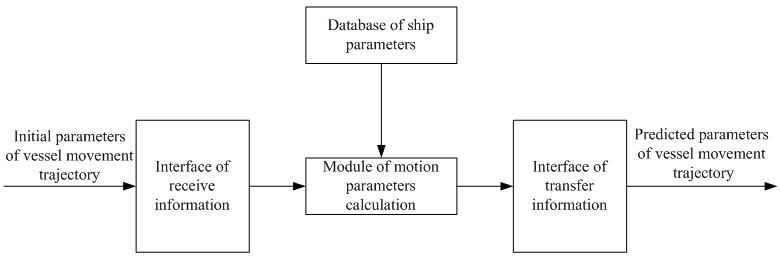
Figure 2 – General structure of subsystem for calculation the parameters of ship movement trajectory
Subsystem for calculation the parameters of movement contains the following modules: interface of receive information, database of ship parameters, interface of transfer information and module of calculation. Interface of receive information takes initial parameters of vessel movement trajectory from the other modules of INS. Database of ship parameters contains characteristics that describe a particular ship. Interface of transfer information transmits predicted parameters of vessel movement trajectory from module of calculation to the other modules of INS. Module of motion parameters calculation based on mathematical model of vessel movement with using its parameters from the database and initial parameters of the movement.
4.2 Mathematical model of ship movement
Calculation of vessel movement parameters is carried out on the basis of mathematical model. Let's consider mathematical model of vessel movement in the horizontal plane. The coordinate system of the vessel is given in figure 3.
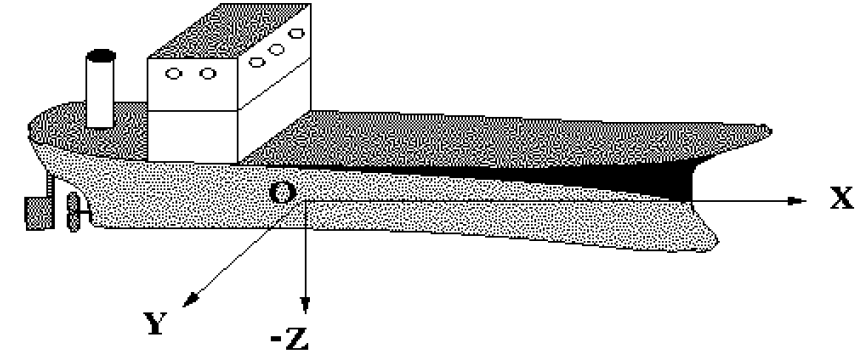
Figure 3 – The coordinate system of the vessel
Maneuvers of the vessel in the horizontal plane can be described by means of the following model [26]:

where m – vessel mass; vX and vY – vessel speed on an axis X and Y respectively; ω – angular vessel speed; L – vessel length; JZ – moment inertia of vessel mass; lR – distance from the vessel center to the propulsion and steering complex (PSC); ZP – number of PSC; XA, YA, MA – longitudinal, lateral forces and the moment of aerodynamic forces which affect surface part of vessel; TRi and YRi – useful traction and lateral force of PSC with an index i; k11, k22 – attached vessel masses at movement on axes X and Y respectively; k66 – attached vessel moment inertia; k26 – attached static moment; R – water resistance; YK – lateral hydrodynamic force of non inertial nature; MK – moment of hydrodynamic forces regarding vertical axis which passes through the vessel center.
The parameters vX, vY, ω are unknown quantities in system of equations (1). All other parameters or are known for a concrete vessel, or pay off on formulas. The system of the differential equations solves for finding of unknown quantities. Speeds on an axis X and Y, angular speed describe dynamics of vessel movement in the horizontal plane in each time point.
The system of equations (1) considerably becomes simpler at some modes of movement. For example, the system of equations (1) becomes for circular movement of vessel:
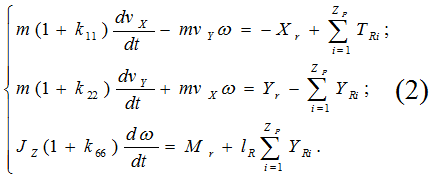
where Xr, Yr and Mr – hydrodynamic efforts of the hull.
The subsystem for calculation the coordinates of movement trajectory solves Cauchy problem for system of equations (1). Previously the system of equations (1) will be transformed to a look which is convenient for application of numerical methods. The definition of Cauchy problem for system of equations (1) is given below:
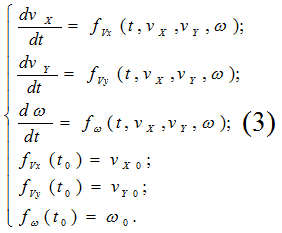
where t0 – initial time of research of vessel movement; vX0, vY0 – speed of vessel movement on an axis X and Y respectively in an initial time point t0; ω0 – angular vessel speed in t0.
Method Runge-Kutta of the fourth-order is applied to the decision system of equations (3). This method is one of the most widespread numerical methods for solution of the differential equations and their systems. Method Runge-Kutta is shown in figure 4 on the example of the solution ordinary differential equation of first order.
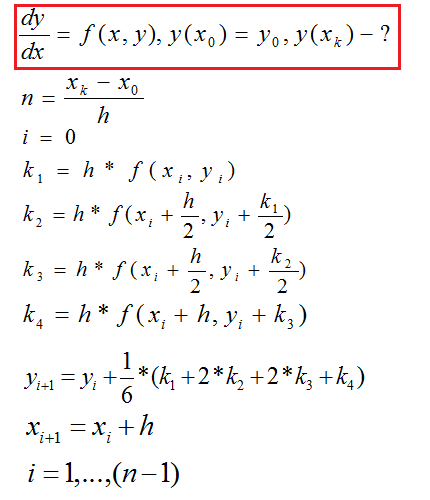
Figure 4 – The solution of differential equation by the method Runge-Kutta of the fourth-order
(animation: 10 frames, 5 repeat cycles, 1 second interval between frames, size of 80,3 kilobytes)
(h – integration step, n – number of integration steps)
5. Experimental results
Research of productivity of subsystem for calculation the coordinates of ships movement trajectory is carried out at realization on two various parallel systems. The first parallel system is based on the dual-core central processor (Intel Core 2 Duo E8500, 3.16 GHz). The second parallel system is based on the video card NVIDIA GeForce GTS 250 with the graphics processor NVIDIA G92b which contains 128 stream processors and supports the CUDA technology. Results of experiments are given in figure 5.
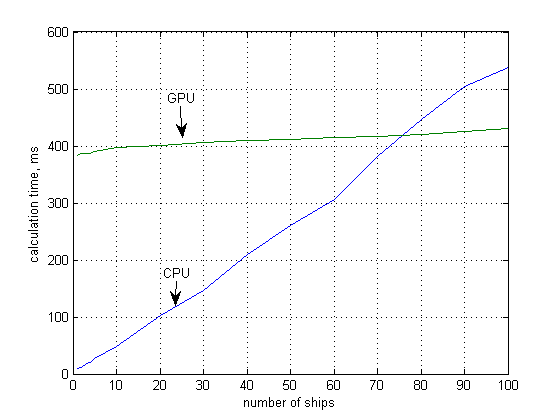
Figure 5 – Results of experiments on the central processor (CPU) and graphics processor (GPU)
Conclusion
At the time of writing of this abstract within the conducted researches are executed:
- review of existing parallel architectures and means of their program support;
- implementation of subsystem for calculation the coordinates of ships movement trajectory on two various parallel systems: the multi-core processor and the graphics processor with CUDA technology support.
Further researches it is planned to direct on the following aspects:
- implement subsystem for calculation the coordinates of ships movement trajectory on a cluster of Donetsk National Technical University;
- make the analysis of work efficiency of a subsystem for calculation the parameters of movement at realization on various parallel systems.
This master's thesis is not completed yet. Final completion: December 2013. The full text of the work and materials on the topic can be obtained from the author or his head after this date.
References
- Анучин О.Н., Емельянцев Г.И. Интегрированные системы ориентации и навигации для морских подвижных объектов. СПб.: Электроприбор, 2003. – 390 с.
- Transportation Research Board [Электронный ресурс]. – Режим доступа: http://www.trb.org/Main/Home.aspx
- Кафедра прикладной механики и управления механико-математического факультета МГУ имени М.В. Ломоносова [Электронный ресурс]. – Режим доступа: http://www.damc.ru/
- Max Planck Institute for Dynamics of Complex Technical Systems [Электронный ресурс]. – Режим доступа: http://www.mpi-magdeburg.mpg.de/
- Bittner R., Driescher A., Gilles E.D. Entwurf einer Vorsteuerung zur hochgenauen Bahnführung von Binnenschiffen. 3. Wismarer Automatisierungssymposium, September 2002. ss. 4-11
- Professor Thor I. Fossen [Электронный ресурс]. – Режим доступа: http://www.itk.ntnu.no/ansatte/Fossen_Thor/
- Marine Systems Simulator [Электронный ресурс]. – Режим доступа: http://www.marinecontrol.org/index.html
- Кафедра Электронные Комплексы Судовождения [Электронный ресурс]. – Режим доступа: http://nav-eks.org.ua/
- Вагущенко Л.Л. Судовые навигационно-информационные системы. – Одесса, Латстар, 2004. – 302 с.
- Аноприенко А.Я., Кривошеев С.В. Разработка подсистемы моделирования движения судна по заданной траектории // Научные труды Донецкого национального технического университета. Выпуск 12. Серия «Вычислительная техника и автоматизация». – Донецк, ДонГТУ, ООО «Лебедь», 1999. С. 197-202. http://ea.donntu.ru:8080/jspui/bitstream/123456789/3462/1/1999-anopriyenko-krivosheeev-ship-simulation.pdf
- Аноприенко А.Я., Кривошеев С.В. Моделирование динамики речного судна на базе системы Matlab/Simulink // «Прогрессивные технологии и системы машиностроения»: Международный сборник научных трудов. – Донецк: ДонГТУ, 2000. Вып. 9. С. 13-20. http://ea.donntu.ru:8080/jspui/bitstream/123456789/3692/1/2000-anopriyenko-krivosheeev-ship-simulation.pdf
- Кривошеев С.В. Исследование эффективности параллельных архитектур вычислительных систем для расчета параметров движения транспортного средства // Научные труды Донецкого национального технического университета. Выпуск № 1(10)-2(11). Серия «Проблемы моделирования и автоматизации проектирования». – Донецк, ДонНТУ, 2012. С. 207-214. http://ea.donntu.ru:8080/jspui/bitstream/123456789/17309/1/12ksvotv.pdf
- Аноприенко А.Я., Кривошеев С.В., Потапенко В.А. Моделирование процесса обработки информации в интегрированной навигационной системе // Тези доповідей міждержавної науково-методичної конференції "Комп'ютерне моделювання" 30 червня – 2 липня 1999 р., м. Дніпродзержинськ. – Дніпродзержинськ. – 1999. С. 114-115. http://ea.donntu.ru:8080/jspui/bitstream/123456789/3694/1/1999-06-30-anopriyenko-krivosheeev-potapenko-ins-simulation.pdf
- Святный В.А., Аноприенко А.Я., Кривошеев С.В., Потапенко В.А. Имитация радиолокационной информации в интегрированной навигационной системе //Сборник трудов VI международной научно-технической конференции «Машиностроение и техносфера на рубеже XXI века» 13-18 сентября 1999 г. В г. Севастополе. – Том 3. – Донецк. – 1999, с. 12-15. http://ea.donntu.ru:8080/jspui/bitstream/123456789/3693/1/1999-09-15-svjatnyj-anopriyenko-krivosheeev-radiolocation-information.pdf
- Кондратенко А.В. Моделирование алгоритмов определения координат в модуле отображения систем логистики [Электронный ресурс]. – Режим доступа: http://masters.donntu.ru/2011/fknt/kondratenko/diss/index.htm
- Гапечкин А.И. Анализ поведения подвижного объекта в замкнутом пространстве [Электронный ресурс]. – Режим доступа: http://masters.donntu.ru/2011/fknt/gapechkin/diss/index.htm
- Паршин А.Н. Вычисление координат подвижного объекта [Электронный ресурс]. – Режим доступа: http://masters.donntu.ru/2010/fknt/parshin/diss/index.htm
- Порицкий А.В. Алгоритмы генерации траектории движения подвижного объекта [Электронный ресурс]. – Режим доступа: http://masters.donntu.ru/2010/fknt/poritskiy/diss/index.htm
- Классификация архитектур по параллельной обработке данных [Электронный ресурс]. – Режим доступа: http://www.csa.ru/analitik/distant/q_4.html
- Multi-core processor [Электронный ресурс]. – Режим доступа: http://en.wikipedia.org/wiki/Multi-core_processor
- Казеннов А. М. Основы технологии CUDA // Компьютерные исследования и моделирование Т. 2 № 3. – 2010. – c. 295-308.
- Linux. Кластер. Практическое руководство по параллельным вычислениям [Электронный ресурс]. – Режим доступа: http://cluster.linux-ekb.info/
- The OpenMP API specification for parallel programming [Электронный ресурс]. – Режим доступа: http://openmp.org/wp/
- CUDA Parallel Computing Platform [Электронный ресурс]. – Режим доступа: http://www.nvidia.com/object/cuda_home_new.html
- Message Passing Interface Forum [Электронный ресурс]. – Режим доступа: http://www.mpi-forum.org/
- Ходкость и управляемость судов. Под ред. В.Г. Павленко. М.: Транспорт, 1991. – 396 с.
